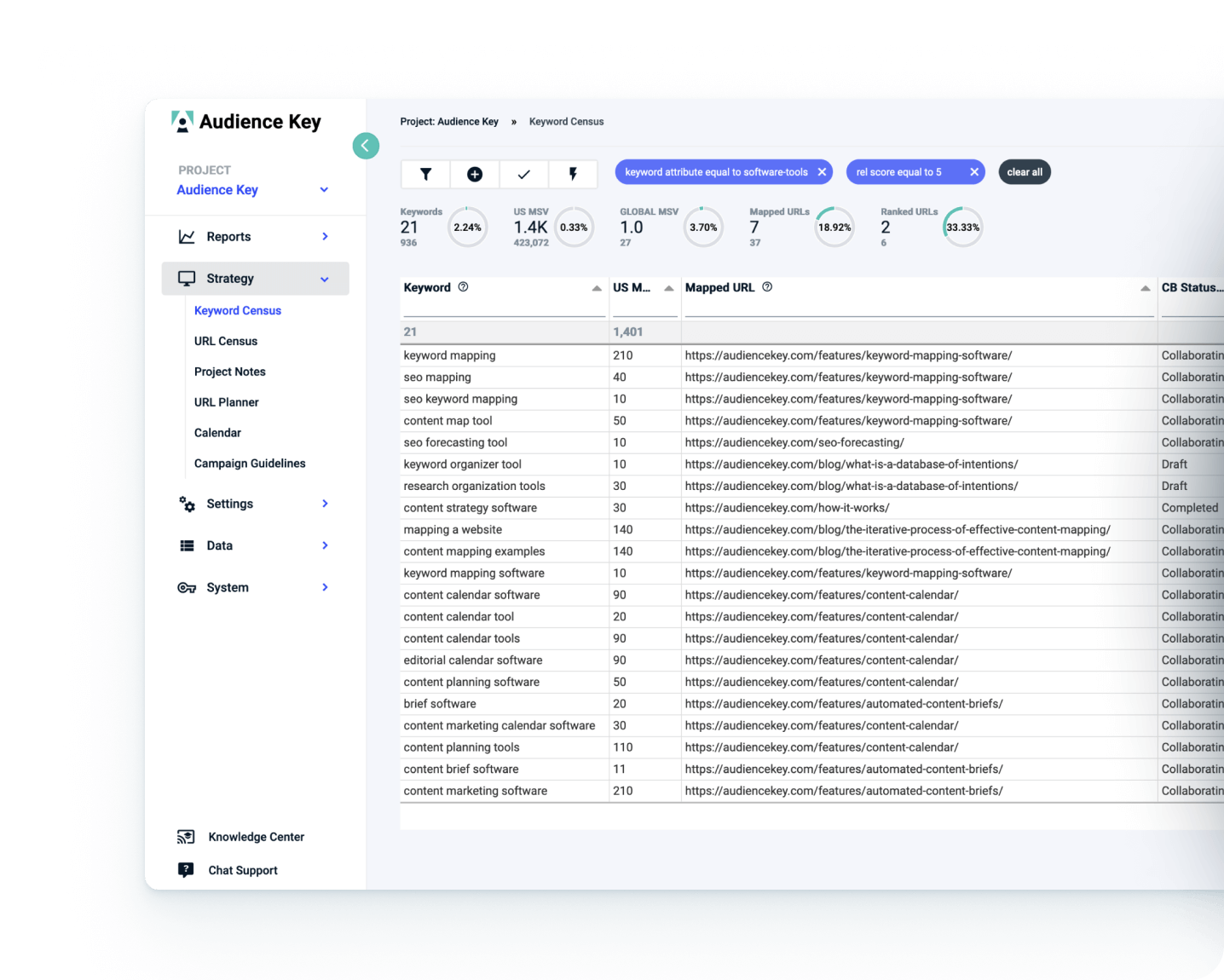Keyword research data is more available and robust than ever before, and SEOs and content marketers are getting ever more sophisticated with how they are collecting and utilizing this data to drive their strategy.
Even for small to midsize programs it is appropriate to evaluate and organize many thousands of keyword phrases. But once you have your keyword list, how do you best organize it, operationalize it into your optimization and creation processes, and loop back in your performance tracking?
The disconnect between keyword research lists, workflow, and result measurement remains a huge pain point.
Spreadsheets?
For many, including my team, the go-to mechanism for managing keyword strategy has been spreadsheets. In our case, these spreadsheets over time grew in sophistication, and inevitably, in complexity. Using spreadsheets to organize, segment, and map keywords was a good starting point, but still fell far short of what we wanted to accomplish:
- Syndicate our keyword mapping into the content planning and optimization process to ensure strategy translated into effectively into production work
- Track the progress of our keyword rankings over time to validate the efficacy of our work, while also monitoring any evolution of competitors
- Identify next level opportunities for further optimization and plan out forthcoming strategic work
While crudely effective, spreadsheets quickly became unwieldy. Collaboration and version control were constant challenges. Keeping the data managed and up-to-date proved a sisyphean task. Making this data clear and discernable to clients left tons to be desired. Our strategists were spending the majority of their time keeping strategy and reporting data organized, rather than using this precious time to be…strategic. We got darn good with vlookups and pivot tables- but that’s not really the objective, is it.
Strategy, Workflow, & Reporting Are Not Connected – The Struggle Is Real
There are many excellent point tools both to get upfront SEO data and to track downstream results. But what about the middle processes that lie between research data and end result reporting? These middle processes are commonly still managed with a crude amalgamation of spreadsheets, project management tools, word docs, and ancillary analytics and ranking tools.
What’s ideal is something akin to an ‘ERP’ for the SEO and content marketing industry: meaning a system that centrally handles the functions often conducted with disparate tools and systems. The components for such a system include data organization, collaborative strategy planning, content optimization, result measurement, and the feedback loop to repeat optimization processes for further refinement. Each of these components are connected and fluid; using a host of disparate tools and systems totally compromises this interconnectedness.
Evolving to a Connected System
As I described earlier, our spreadsheets were getting more sophisticated and complex as they evolved to handle more data points and more workflow management. The situation was screaming for technology, but nothing existed. So we began constructing a system that brought connectivity to the full process of organizing keyword data into actionable strategic planning, workflow, and measurement. Two core concepts stayed front and center throughout this process:
- Make data actionable
- Make results clear and discernable
Keyword Mapping Software
The first step was to build software for keyword organizing and mapping. Aggregate your keyword terms and map them to their intended page (be it a page that exists or a page that needs to be created). Mapping is a one-to-many process: many keyword terms are mapped to one page, but a keyword term must be designated to only one specific page. A thorough mapping process is critical when it comes time to optimize a page, as well as avoid unintentionally optimizing multiple pages for the same phrase clusters (which in turn creates keyword blurring).
Keyword Attributes
At first appearance, mapping is easy enough to do in a spreadsheet. That is, until you want to start doing more sophisticated things. For example, building filters for keyword attributes vs. simple filters. This opens up a whole additional level of sophistication to segment terms into clusters and aid in your mapping process.
Example: I have over 5,000 keyword terms. Filtering down to see how many terms contain the word ‘cheap’ is simple enough. But perhaps what you really want to know is how many terms relate to price sensitivity? That would include phrases which include cheap, discount, affordable, coupon, low cost, low price, etc. A keyword attribute can automatically classify all keyword phrases expressing this sentiment, which is super helpful for mapping, competitor analysis, and segmentation reporting.
Efficiency & Collaboration
In lieu of mapping inside of a spreadsheet, mapping software can be designed to make this iterative process significantly more efficient. For example, building filtering technology expressly designed to allow rapid drill down into segments of a keyword list. Bulk update buttons allow quick and easy updating of the keyword database to assign or change target mapping on the fly. Cloud based workflow implies version control of a master file is no longer an issue; team members can collaboratively work in real time coordinating their assessments and updates to a strategic plan.
URL Management & Planning
Important terms in your mapping list often don’t have an appropriate existing page to which to map. This is where creating additional (not currently existing) URL options enters the picture. Mapping software makes it easy to assign and organize statuses to mapped URLs- allowing strategy segmentation between pages that exist vs. pages worth exploring to create.
At the end of the mapping process a portion of keywords will be mapped to existing pages, and a portion mapped to pages that need to be created. Each page has an identified number of unique keyword terms and their associated monthly search volume.
Optimization decisions for existing pages are based on the mapped keyword strategy. Explored new concept pages can be further segmented into strategic statuses: after exploring a new page concept, that page can be updated to proposed for creation (for collaborative team review), planned (and given a target creation date), sidelined (for later phase development), or dismissed (expressly decided not to develop).
Presto – you now have the foundations of a data driven content roadmap.
System Created Content Briefs
Once keywords are expressly assigned to a page we can leverage this to inform optimization changes to an existing page, or insights into creating the content for new pages. A system that automatically creates a strategic content brief for each mapped page is a first big output advantage of a connected system.
Dynamic Updates to Keyword Mapping
Keyword mapping is an iterative process: expect constant updates as keywords are remapped to pages and new keywords are added to an evolving strategy. Content briefs dynamically drawing from keyword mapping software in real time provide incredible workflow efficiency.
Automatically Updated Data Reporting
Working within the content brief, an important reference point is to know the ranking position and SERP features (such as, does an Answer Box publish in the SERP) for each mapped keyword phrase. A system that automatically updates these data points in the content brief provides significant lift in workflow efficiency and insight.
Optimizing Existing Content
For published pages, ingesting currently published page content and SEO metadata (such as title tag and meta description) into the content brief, justposing content with the expressed keyword mapping in once centralized place. Optimization recommendations can now be identified, recorded, and shared.
Centralized Collaboration
Connected content briefs further facilitate collaboration and workflow. Status and setting decisions made from inside the content brief work environment trigger updates throughout the system. Content fields for documenting and sharing strategy and planning notes provide additional centralized collaboration benefits.
Native Tracking & Reporting
Keyword rank tracking (your rankings as well as competitor rankings) connected at the hip to your keyword and page strategy is the ultimate benefit of an integrated system. Incredible new dimensions of insights spring up while the arduous task of constantly importing and curating updated ranking results is eliminated. Keener insights. Less work.
Reporting Tied to Strategy
Mapped URLs are the strategic theory of what page should rank for each term: the current ranking URL is the current reality. A system that integrates ranking data vis a vis your strategic mapping plan quickly highlights disconnects between theory and reality. Competitor ranking data for these same keywords, integrated into your strategy reporting, facilitates ease of insights into competitor analysis.
A Whole New Level of Segmentation Reporting
With reporting tied directly to strategic mapping, the sophistication and flexibility of segmentation reporting shoots the moon. View the progress or competitive benchmarking of your entire campaign, and then slice and dice this down in myriad ways: such as by keyword attribute, section, page type, persona, page author, funnel stage, page status, SERP feature, mapping vs. ranking URL match, or by optimization status (report on the growth for just the pages we’ve optimized so far, for example).
Summary
Keyword mapping should be core to any well run SEO content marketing program. However, when managed in its own silo (such as a spreadsheet), the power of a mapping process is greatly diminished. When mapping strategy is connected to the follow-on workflow and reporting processes via a holistic system, strategic benefits of keyword mapping are tremendously increased.
Conclusion
Several years have been spent building Audience Key, the connected strategy system that solves this big missing piece between upfront data and downstream reporting. It’s the next logical and necessary step in the evolution of tech enablement for SEO’s and content marketers.
A suite of native software solutions that form a connected end-to-end content marketing strategy system.




